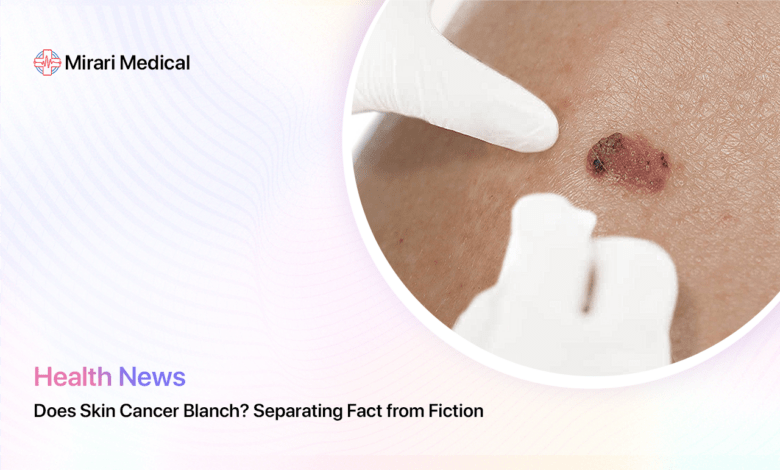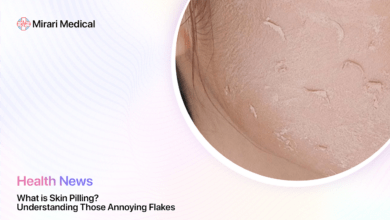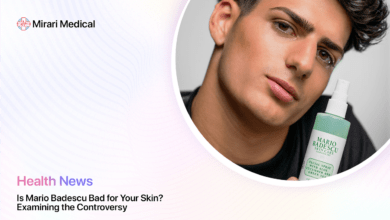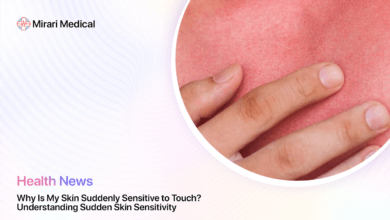Does Skin Cancer Blanch? Separating Fact from Fiction

You may be interested
Skin cancer is a serious concern, and early detection is crucial. This guide explores the concept of blanching in skin cancer diagnosis and offers valuable information on identifying suspicious lesions.
Unveiling the Truth: Blanching and Skin Cancer – Not a Definitive Test
When it comes to detecting skin cancer, many people have heard about the “blanching test.” This involves pressing on a suspicious mole or lesion to see if it temporarily turns white. While blanching can be a clue for some skin cancers, it’s not a reliable indicator and shouldn’t be used for sole diagnosis.
“While blanching can be a clue for some skin cancers, it’s not a reliable indicator and shouldn’t be used for sole diagnosis.”
It’s essential to understand that not all skin cancers will blanch when pressure is applied. Melanoma, the most serious type of skin cancer, often does not exhibit blanching. On the other hand, some benign lesions may turn white when pressed, leading to unnecessary worry.
The importance of consulting a dermatologist cannot be overstated. These skin specialists have the expertise and tools to accurately diagnose skin cancer. They will consider various factors, including the appearance, size, shape, and color of the lesion, along with any changes over time. If necessary, they may perform a biopsy, which involves removing a small sample of the suspicious tissue for laboratory analysis. This is the definitive method for diagnosing skin cancer.
While the blanching test may seem like a quick and easy way to self-diagnose, it’s crucial not to rely on it. Skin cancer is a serious condition that requires professional evaluation. Attempting to diagnose yourself based on blanching alone can lead to delayed treatment and potentially dangerous consequences.
If you notice any concerning changes in your skin, such as the appearance of a new mole, a change in an existing mole, or a lesion that doesn’t heal, it’s essential to schedule an appointment with a dermatologist promptly. They can properly assess the situation and determine the best course of action.
Understanding Blanching: A Temporary Skin Color Change
Blanching refers to the temporary lightening or whitening of the skin when pressure is applied. This occurs because the pressure temporarily restricts blood flow to the area, causing the skin to appear lighter.
It’s important to note that blanching is not specific to skin cancer. Many benign skin lesions, such as cherry angiomas or dermatofibromas, may also exhibit blanching when pressure is applied. Therefore, the presence or absence of blanching alone cannot determine whether a lesion is cancerous.
Blanching can be a helpful tool for dermatologists during a physical examination, as it can provide clues about the nature of a lesion. However, it is just one piece of the diagnostic puzzle. Dermatologists will consider various other factors, such as the ABCDE criteria (asymmetry, border irregularity, color, diameter, and evolution) when evaluating a suspicious mole or lesion.
When Does Blanching Occur in Skin Cancer? Exploring Possibilities
While blanching is not a definitive test for skin cancer, it can occur in certain types of skin cancers. For example, some basal cell carcinomas (BCCs), which are the most common type of skin cancer, may exhibit blanching when pressure is applied. This is known as the “basal cell blanche” sign.
However, it’s crucial to remember that not all BCCs will blanch, and the absence of blanching does not rule out the possibility of skin cancer. Additionally, other types of skin cancers, such as squamous cell carcinoma (SCC) and melanoma, may not consistently exhibit blanching.
When evaluating a suspicious lesion, dermatologists will consider various visual signs beyond blanching. These include changes in size, shape, or color, as well as the presence of asymmetry, irregular borders, or multiple colors within the lesion.
It’s also essential to be aware of any new or changing lesions on your skin. Regularly performing self-examinations and noting any unusual growths, sores that don’t heal, or changes in existing moles can help with early detection. If you notice anything concerning, it’s crucial to bring it to the attention of a dermatologist promptly.
Beyond Blanching: Key Visual Signs of Skin Cancer
While blanching can be a potential clue for certain skin cancers, it’s essential to be aware of other key visual signs that may indicate the presence of skin cancer. The ABCDE rule is a helpful guide for identifying potential melanomas:
- Asymmetry: One half of the mole or lesion does not match the other half.
- Border irregularity: The edges of the mole are ragged, notched, or blurred.
- Color variation: The mole contains multiple colors or an uneven distribution of color.
- Diameter: The mole is larger than 6 millimeters (about the size of a pencil eraser).
- Evolution: The mole is changing in size, shape, or color over time.
It’s important to note that not all melanomas will exhibit all of these characteristics, and some benign moles may have one or more of these features. However, if you notice any of these signs, it’s crucial to have the lesion evaluated by a dermatologist.
In addition to the ABCDE rule, other warning signs of skin cancer include:
- A sore that doesn’t heal within a few weeks
- A new, persistent bump or patch on the skin
- A mole that looks different from your other moles
- A spot that itches, bleeds, or becomes painful
Being familiar with your skin and regularly checking for any changes can help with early detection. If you notice anything unusual or concerning, don’t hesitate to schedule an appointment with a dermatologist.
What about itching, bleeding, or crusting?
In addition to visual changes, other symptoms can be associated with skin cancer. These include:
- Itching or tenderness in a mole or lesion
- Bleeding or oozing from a mole or lesion
- Crusting or scabbing of a mole or lesion
If you experience any of these symptoms, it’s important to consult a dermatologist promptly. While these signs can occur with benign skin conditions, they can also be indicative of skin cancer. A dermatologist can properly evaluate the lesion and determine the appropriate course of action.
Don’t Ignore It: When to See a Dermatologist
If you notice any suspicious changes in your skin, it’s essential not to ignore them. Early detection is crucial for successful skin cancer treatment. Here are some situations when you should schedule an appointment with a dermatologist:
- You notice a new mole or lesion that looks different from your other moles
- An existing mole or lesion changes in size, shape, or color
- A mole or lesion becomes itchy, painful, or starts bleeding
- A sore on your skin doesn’t heal within a few weeks
- You have a family history of skin cancer or excessive sun exposure
Don’t hesitate to seek professional advice if you have any concerns about your skin. Dermatologists are trained to identify and diagnose skin cancers, and they can provide appropriate treatment options based on the type and stage of the cancer.
Remember, early detection saves lives. When skin cancer is caught and treated early, the chances of successful treatment are much higher. Regular skin self-exams and annual check-ups with a dermatologist can help ensure that any potential issues are identified and addressed promptly.
Skin Self-Exams: Taking Control of Your Skin Health
In addition to regular check-ups with a dermatologist, performing monthly skin self-exams is an essential part of maintaining your skin health. By becoming familiar with your skin and regularly checking for any changes, you can help detect potential skin cancers early.
Here’s how to perform a skin self-exam:
- Stand in front of a full-length mirror in a well-lit room.
- Examine your face, neck, ears, and scalp. Use a hand mirror to view hard-to-see areas.
- Check your arms, hands, and fingernails. Don’t forget to look at the spaces between your fingers and the undersides of your arms.
- Examine your chest, abdomen, and trunk. Women should lift their breasts to check the skin underneath.
- Turn around and use the hand mirror to inspect your back, buttocks, and the back of your legs.
- Sit down and closely examine your legs, ankles, feet, and toenails. Check the soles of your feet and the spaces between your toes.
If you notice any new, changing, or unusual moles or lesions during your self-exam, make an appointment with a dermatologist for a professional evaluation. It’s also helpful to take photos of any concerning spots so you can monitor them for changes over time.
Taking photos of suspicious lesions allows you to compare them side-by-side and track any changes that occur. If you notice a mole or lesion evolving in size, shape, or color, it’s essential to bring it to the attention of a dermatologist promptly.
Remember, skin self-exams are not a substitute for professional skin cancer screenings. It’s important to schedule annual check-ups with a dermatologist, especially if you have a history of excessive sun exposure, a family history of skin cancer, or a large number of moles.
Understanding Different Skin Cancer Types
Skin cancer is not a single disease but rather a group of cancers that affect the skin. The three main types of skin cancer are:
Melanoma
Melanoma is the most aggressive form of skin cancer. It develops in the melanocytes, the cells that produce the pigment that gives skin its color. Melanoma can occur anywhere on the body, even on areas that are not typically exposed to the sun.
Early detection is crucial for successful treatment of melanoma. The five-year survival rate for melanoma that is caught and treated early (before it has spread to lymph nodes or other organs) is 99%. However, if melanoma is not detected until it has spread to distant organs, the five-year survival rate drops to just 27%.
The ABCDE rule is particularly important for identifying potential melanomas. If you notice a mole or lesion that exhibits any of the ABCDE characteristics, it’s essential to have it evaluated by a dermatologist promptly.
Basal Cell Carcinoma
Basal cell carcinoma (BCC) is the most common type of skin cancer. It develops in the basal cells, which are located in the lower part of the epidermis (the outermost layer of skin). BCC most often occurs on areas of the skin that have been exposed to the sun, such as the face, ears, neck, and hands.
BCC is highly treatable when caught early. It rarely spreads to other parts of the body, but it can grow into nearby tissues and cause damage if left untreated. Treatment options for BCC include surgical excision, cryotherapy (freezing), topical medications, and radiation therapy.
Squamous Cell Carcinoma
Squamous cell carcinoma (SCC) is the second most common type of skin cancer. It develops in the squamous cells, which are located in the upper part of the epidermis. Like BCC, SCC most often occurs on sun-exposed areas of the skin.
SCC is also highly treatable when detected early, but it is more likely than BCC to spread to other parts of the body if left untreated. Treatment options for SCC are similar to those for BCC and may include surgical excision, cryotherapy, topical medications, and radiation therapy.
It’s important to be familiar with the warning signs of each type of skin cancer and to bring any concerning lesions to the attention of a dermatologist. Early detection and treatment are key to achieving the best possible outcomes.
Sun Protection: Your Best Defense Against Skin Cancer
One of the most effective ways to reduce your risk of developing skin cancer is to protect your skin from the sun’s harmful ultraviolet (UV) rays. UV radiation is a known carcinogen and is responsible for the majority of skin cancer cases.
Here are some key sun protection strategies:
Daily Sunscreen Use
Wearing sunscreen every day is one of the most important things you can do to protect your skin from UV damage. Choose a broad-spectrum sunscreen with an SPF (sun protection factor) of at least 30. Broad-spectrum means that the sunscreen protects against both UVA and UVB rays.
Apply sunscreen generously to all exposed areas of skin, including your face, neck, ears, and hands. Reapply every two hours, or more often if you are swimming or sweating heavily.
Sun-Protective Clothing
In addition to sunscreen, wearing sun-protective clothing can provide an extra layer of defense against UV rays. Look for clothing with a UPF (ultraviolet protection factor) rating, which indicates how much UV radiation the fabric blocks.
Long-sleeved shirts, long pants, and wide-brimmed hats are all good options for sun protection. Don’t forget to protect your eyes with UV-blocking sunglasses as well.
Seek Shade and Avoid Peak Sun Hours
Whenever possible, seek shade during the sun’s peak hours, which are typically between 10 a.m. and 4 p.m. If you must be outdoors during these times, be sure to wear sunscreen and protective clothing.
Remember, UV rays can penetrate clouds and reflect off surfaces like water, sand, and snow, so sun protection is important even on cloudy or cool days.
By making sun protection a daily habit, you can significantly reduce your risk of developing skin cancer and other sun-related skin damage, such as premature aging and sunburn.
Dispelling Myths: Beyond Blanching in Skin Cancer Diagnosis
While blanching can be a potential indicator of certain skin cancers, it’s important to understand its limitations in the diagnostic process. Here are some key points to keep in mind:
Limitations of Visual Diagnosis
Visual examination, including the blanching test, is an important first step in identifying potentially cancerous lesions. However, it is not a definitive diagnostic tool. Some skin cancers may not exhibit blanching, while some benign lesions may blanch when pressure is applied.
It’s essential to remember that only a biopsy can provide a definitive diagnosis of skin cancer. During a biopsy, a small sample of the suspicious tissue is removed and examined under a microscope to determine whether cancer cells are present.
Other Diagnostic Tools Used by Dermatologists
In addition to visual examination and biopsy, dermatologists may use other tools to aid in the diagnosis of skin cancer. These include:
- Dermoscopy: Also known as dermatoscopy or epiluminescence microscopy, this technique involves using a handheld device called a dermatoscope to magnify and illuminate the skin. This allows the dermatologist to see structures and patterns that are not visible to the naked eye, which can help distinguish between benign and cancerous lesions.
- Imaging tests: In some cases, imaging tests such as CT scans, MRIs, or PET scans may be used to determine whether skin cancer has spread to other parts of the body.
It’s important to understand that while these tools can provide valuable information, they are not a substitute for a biopsy in diagnosing skin cancer.
FAQs
I noticed a mole that turns white when I press on it. Should I be worried?
While blanching can be a sign of certain skin cancers, it can also occur in benign lesions. If you notice any new or changing moles or lesions, it’s important to have them evaluated by a dermatologist. They can determine whether further testing, such as a biopsy, is needed.
What are some other warning signs of skin cancer besides blanching?
In addition to blanching, other warning signs of skin cancer include:
- Asymmetry: One half of the mole or lesion does not match the other half.
- Border irregularity: The edges of the mole are ragged, notched, or blurred.
- Color variation: The mole contains multiple colors or an uneven distribution of color.
- Diameter: The mole is larger than 6 millimeters (about the size of a pencil eraser).
- Evolution: The mole is changing in size, shape, or color over time.
If you notice any of these signs, it’s important to have the lesion evaluated by a dermatologist.
How often should I perform a skin self-exam?
It’s recommended to perform a thorough skin self-exam once a month. This allows you to become familiar with your skin and notice any changes or new growths that may be of concern. If you notice anything suspicious, schedule an appointment with a dermatologist for further evaluation.
Can I rely on home tests to diagnose skin cancer?
No, home tests are not a reliable way to diagnose skin cancer. While some smartphone apps claim to be able to analyze moles and lesions, they are not a substitute for a professional evaluation by a dermatologist. If you have any concerns about a mole or lesion, it’s essential to have it examined by a qualified medical professional.
I’m concerned about a skin lesion, but I don’t have health insurance. What are my options?
If you don’t have health insurance, there are still options for getting a skin cancer screening. Some dermatologists offer reduced-fee or free screenings for uninsured patients. You can also check with local health clinics or community health centers, which may offer low-cost or sliding-scale services. The American Academy of Dermatology also offers free skin cancer screenings at various locations throughout the country. Check the American Academy of Dermatology website for more information on free skin cancer screenings in your area.
The Bottom Line: Early Detection Saves Lives
When it comes to skin cancer, early detection is key. While blanching can be a potential indicator of certain skin cancers, it’s not a definitive test. The most important thing you can do for your skin health is to be proactive and vigilant.
Perform regular skin self-exams, protect your skin from the sun, and don’t hesitate to schedule an appointment with a dermatologist if you notice any concerning changes. Remember, a professional evaluation is the only way to definitively diagnose skin cancer.
By being informed and taking control of your skin health, you can catch potential issues early and improve your chances of successful treatment. Your skin is your body’s largest organ and its first line of defense – treat it with the care and attention it deserves.
Key Takeaways
- Blanching, or the temporary lightening of skin when pressure is applied, can be a potential indicator of certain skin cancers but is not a definitive test.
- Not all skin cancers exhibit blanching, and some benign lesions may blanch when pressed.
- The ABCDE rule (Asymmetry, Border irregularity, Color variation, Diameter, Evolution) is a helpful guide for identifying potential melanomas.
- Regular skin self-exams and professional check-ups with a dermatologist are crucial for early detection of skin cancer.
- Protecting your skin from the sun’s harmful UV rays is one of the most effective ways to reduce your risk of developing skin cancer.
- If you notice any concerning changes in your skin, don’t hesitate to schedule an appointment with a dermatologist for a professional evaluation.
Remember, knowledge is power when it comes to your skin health. By understanding the signs and symptoms of skin cancer, practicing sun safety, and being proactive about your skin care, you can be your own best advocate in the fight against skin cancer.
Your trusted source for health info, offering expert advice, news, and tips to stay healthy and informed.





